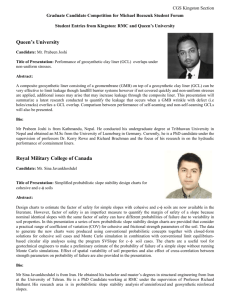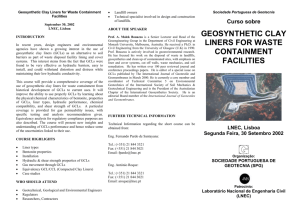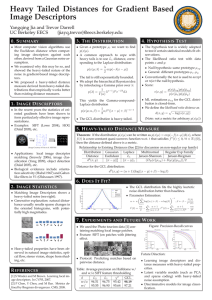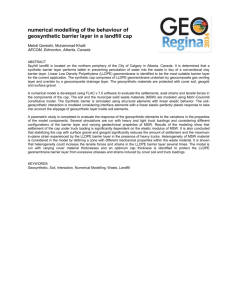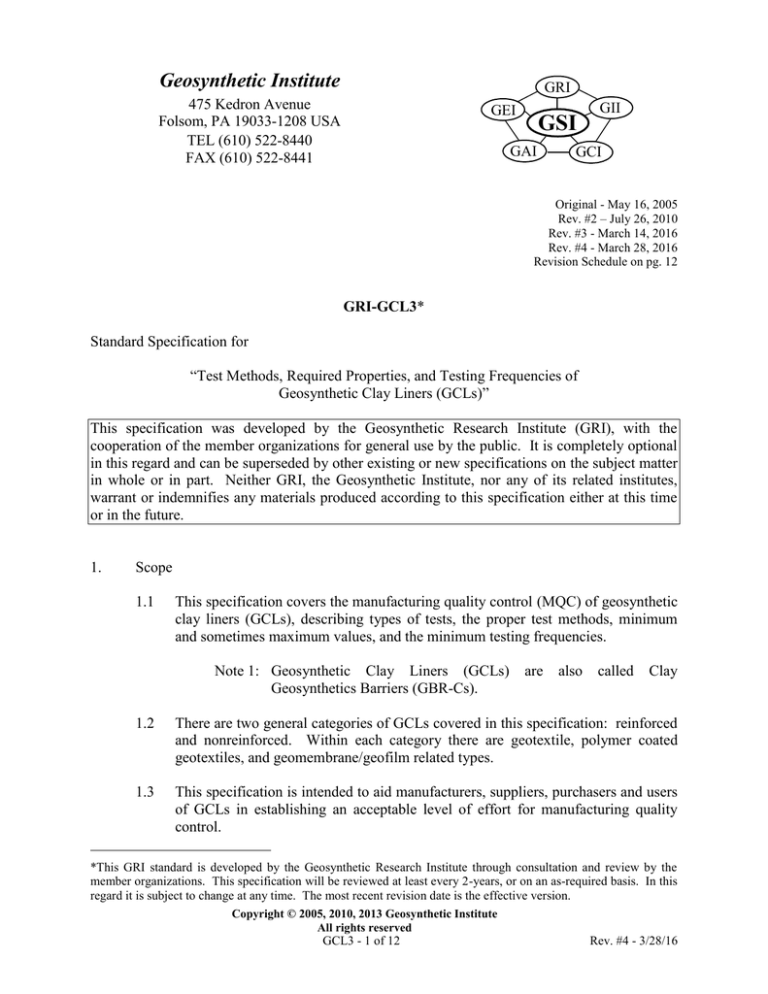
Geosynthetic Institute
GRI
475 Kedron Avenue
Folsom, PA 19033-1208 USA
TEL (610) 522-8440
FAX (610) 522-8441
GEI
GSI
GAI
GII
GCI
Original - May 16, 2005
Rev. #2 – July 26, 2010
Rev. #3 - March 14, 2016
Rev. #4 - March 28, 2016
Revision Schedule on pg. 12
GRI-GCL3*
Standard Specification for
“Test Methods, Required Properties, and Testing Frequencies of
Geosynthetic Clay Liners (GCLs)”
This specification was developed by the Geosynthetic Research Institute (GRI), with the
cooperation of the member organizations for general use by the public. It is completely optional
in this regard and can be superseded by other existing or new specifications on the subject matter
in whole or in part. Neither GRI, the Geosynthetic Institute, nor any of its related institutes,
warrant or indemnifies any materials produced according to this specification either at this time
or in the future.
1.
Scope
1.1
This specification covers the manufacturing quality control (MQC) of geosynthetic
clay liners (GCLs), describing types of tests, the proper test methods, minimum
and sometimes maximum values, and the minimum testing frequencies.
Note 1: Geosynthetic Clay Liners (GCLs)
Geosynthetics Barriers (GBR-Cs).
are
also
called
Clay
1.2
There are two general categories of GCLs covered in this specification: reinforced
and nonreinforced. Within each category there are geotextile, polymer coated
geotextiles, and geomembrane/geofilm related types.
1.3
This specification is intended to aid manufacturers, suppliers, purchasers and users
of GCLs in establishing an acceptable level of effort for manufacturing quality
control.
*This GRI standard is developed by the Geosynthetic Research Institute through consultation and review by the
member organizations. This specification will be reviewed at least every 2-years, or on an as-required basis. In this
regard it is subject to change at any time. The most recent revision date is the effective version.
Copyright © 2005, 2010, 2013 Geosynthetic Institute
All rights reserved
GCL3 - 1 of 12
Rev. #4 - 3/28/16
2.
1.4
This specification does not address manufacturing quality assurance (MQA),
product acceptance testing, or conformance testing. These are independent
activities taken by organizations other than the GCL manufacturer.
1.5
The values stated in SI (metric) units are to be regarded as the standard. The U.S.
(English) units are calculated values using a “soft” conversion accuracy.
1.6
This standard does not purport to address all of the safety concerns, if any,
associated with its use. It is the responsibility of the user of this standard to
establish appropriate safety and health practices and determine the applicability of
regulatory limitations prior to use.
Referenced Documents
2.1
ASTM Standards
D 638
D 792
D 882
D 1141
D 1505
D 4354
D 4439
D 4632
D 4759
D 5199
D 5261
D 5721
D 5887
D 5888
D 5889
D 5890
D 5891
D 5993
D 5994
D 6102
D 6141
Test Method for Tensile Properties of Plastics
Test Methods for Density and Specific Gravity (Relative Density) of
Plastics by Displacement
Test Method for Tensile Properties of Thin Plastic Sheeting
Practice for Preparation of Substitute Ocean Water
Test Method for Density of Plastics by the Density-Gradient Method
Practice for Sampling of Geosynthetics for Testing
Terminology for Geosynthetics
Test Method for Grab Breaking Load and Elongation of Geotextiles
Practice for Determining the Specification Conformance of
Geosynthetics
Test Method for Measuring Nominal Thickness of Geotextiles and
Geomembranes
Test Method for Measuring Mass per Unit Area of Geotextiles
Practice for Air-Oven Aging of Polyolefin Geomembranes
Test Method for Measurement of Index Flux Through Saturated
Geosynthetic Clay Liner Specimens Using Flexible Wall Permeameter
Practice for Storage and Handling of Geosynthetic Clay Liners
Practice for Quality Control of Geosynthetic Clay Liners
Test Method for Swell Index of Clay Mineral Component of
Geosynthetic Clay Liners
Test Method for Fluid Loss of Clay Component of Geosynthetic Clay
Liners
Test Method for Measuring the Mass Per Unit Area of Geosynthetic
Clay Liners
Test Method for Measuring the Core Thickness of Textured
Geomembrane
Guide for Installation of Geosynthetic Clay Liners
Guide for Screening the Clay Portion of a GCL for Chemical
Compatibility to Liquids
GCL3 - 2 of 12
Rev. #4 - 3/28/16
D 6243 Method for Determining the Internal and Interface Shear Resistance of
Geosynthetic Clay Liner by the Direct Shear Method
D 6495 Guide for Acceptance Testing Requirements for Geosynthetic Clay
Liners
D 6496 Test Method for Determining Average Bonding Peel Strength Between
the Top and Bottom Layers of Needle-Punched Geosynthetic Clay
Liners
D 6693 Test Method for Determining Tensile Properties of Nonreinforced
Polyethylene and Nonreinforced Flexible Polypropylene Geomembranes
D 6766 Test Method for Evaluation of Hydraulic Properties of Geosynthetic
Clay Liners Permeated with Potentially Incompatible Liquids
D 6768 Test Method for Tensile Strength of Geosynthetic Clay Liners
2.2
GRI Standards
GM13
GM17
GM18
2.3
Test Properties, Testing Frequency and Recommended Warrant for High
Density Polyethylene (HDPE) Smooth and Textured Geomembranes
Test Properties, Testing Frequency and Recommended Warranty for
Linear Low Density Polyethylene (LLDPE) Smooth and Textured
Geomembranes
Test Properties, Testing Frequency and Recommended Warrant for
Flexible Polypropylene (fPP and fPP-R) Nonreinforced and Reinforced
Geomembranes (Presently suspended as of May 3, 2004)
Government Document:
U.S. Environmental Protection Agency Technical Guidance Document “Quality
Control Assurance and Quality Control for Waste Containment Facilities,”
EPA/600/R-93/182, September 1993, 305 pgs.
3.
Terminology
3.1
Definition
3.1.1
Geosynthetic Definitions:
3.1.1.1 geotextile, n—a permeability geosynthetic comprised solely of
textiles. (ASTM D 4439)
3.1.1.2 geomembrane, n—an essentially impermeable geosynthetic
barrier composed of one or more synthetic sheets. (ASTM D
4439)
3.1.1.3 geofilm, n—a thin polymeric film which is essentially
impermeable having a thickness no greater than 0.25 mm (10
mils).
3.1.1.4 geotextile-polymer, n—a geotextile which has been coated with,
or impregnated by, a polymer such as polypropylene
GCL3 - 3 of 12
Rev. #4 - 3/28/16
3.1.1.5 geosynthetic clay liner, n—a manufactured hydraulic barrier
consisting of clay bonded to a layer or layers of geosynthetic
materials. (ASTM D 4439). Also recall Note 1.
Note 2: Geotextile Related GCL is one in which two geotextiles are used
respectively as cap and carrier to the bentonite. Cap and carrier
designations in this standard refer to respective orientations
during manufacturing. This may or may not be the as-placed
orientation in the field. It can be internally reinforced by needle
punching or stitching, or be nonreinforced.
Geotextile Polymer Coated GCL is one in which two geotextiles
are used respectively as cap and carrier to the encased bentonite,
however, one of the geotextiles has been polymer coated in a
manner that the permeability and flux are decreased. Within this
context a bitumen coated geotextile can be considered as being a
polymer.
Cap and carrier designations refer to the as
manufactured product and not necessarily to the as-placed
orientation. It can be internally reinforced by needle punching or
stitching, or be nonreinforced.
Geomembrane/Geofilm Related GCL is one in which a
geomembrane or geofilm is included in the cross section either
above or below the cap geotextile. It can be internally reinforced
needle punching or be nonreinforced. Also in the nonreinforced
category is bentonite adhesively bonded to a geomembrane.
3.1.2
Material Definitions
3.1.2.1 bentonite—a distinct type of fine-grained clay soil typically
containing not less than 80% montmorillionite clay, usually
characterized by high swelling upon wetting.
3.1.2.2 Formulation, n - The mixture of a unique combination of
ingredients identified by type, properties and quantity. For
geosynthetic materials, a formulation refers to the exact
percentages of resin, additives, carbon black and/or other
additives. It does not necessarily refer to individual suppliers of
each ingredient.
The individual suppliers must meet the
manufacturer’s internal quality control specification.
3.1.3
Organizational Definitions:
3.1.3.1 installer, n—the party who installs, or facilitates installation of,
any materials purchased from manufacturers or suppliers.
3.1.3.2 manufacturer, n—the group, corporation, partnership, or
individual that manufactures a product.
3.1.3.3 purchaser, n—the person, company, or organization that
purchases any materials or work to be performed.
GCL3 - 4 of 12
Rev. #4 - 3/28/16
3.1.3.4 supplier, n—the party who supplies material or services.
3.1.4
Quality Definitions:
3.1.4.1 Manufacturing Quality Control (MQC) - A planned system of
inspections that is used to directly monitor and control the
manufacture of a material which is factory originated. MQC is
normally performed by the manufacturer of geosynthetic
materials and is necessary to ensure minimum (or maximum)
specified values in the manufactured product. MQC refers to
measures taken by the manufacturer to determine compliance with
the requirements for materials and workmanship as stated in
certification documents and contract specifications, ref.
EPA/600/R-93/182
3.1.4.2 Manufacturing Quality Assurance (MQA) - A planned system of
activities that provides assurance that the materials were
constructed as specified in the certification documents and
contract specifications. MQA includes manufacturing facility
inspections, verifications, audits and evaluation of the raw
materials (resins and additives) and geosynthetic products to
assess the quality of the manufactured materials. MQA refers to
measures taken by the MQA organization to determine if the
manufacturer is in compliance with the product certification and
contract specifications for the project, ref. EPA/600/R-93/182
3.1.4.3 Construction Quality Control (CQC) - A planned system of
inspections that are used to directly monitor and control the
quality of a construction project. Construction quality control is
normally performed by the geosynthetics manufacturer or
installer, or for natural soil materials by the earthwork contractor,
and is necessary to achieve quality in the constructed or installed
system. Construction quality control (CQC) refers to measures
taken by the installer or contractor to determine compliance with
the requirements for materials and workmanship as stated in the
plans and specifications for the project, ref. EPA/600/R-93/182
3.1.4.4 Construction Quality Assurance (CQA) - A planned system of
activities that provide assurance that the facility was constructed
as specified in the design. Construction quality assurance
includes inspections, verification, audits, and evaluations of
materials and workmanship necessary to determine and document
the quality of the constructed facility. Construction quality
assurance (CQA) refers to measures taken by the CQA
organization to assess if the installer or contractor is in
compliance with the plans and specifications for a project, ref.
EPA.600/R-93/182
GCL3 - 5 of 12
Rev. #4 - 3/28/16
4.
5.
Significance and Use
4.1
GCLs must be properly manufactured in a manner consistent with a minimum
level of quality control as determined by in-house testing of the final product.
This specification presents the types of tests, standard methods of the testing,
required (usually minimum) test values, and minimum testing frequencies which
should be embodied in the manufacturer’s quality control documents. The quoted
tests, test methods and test values in Table 1 must appear in the MQC plan and
the MQC report.
4.2
It should be clearly recognized that manufacturers may perform additional tests or
at greater frequency than required in this specification, or both. In this case, the
manufacturer’s quality control plan will then take precedence over this
specification.
4.3
It should also be recognized that purchasers and installers of GCLs may require
additional tests or at a great frequency than called for in this specification, or both.
The organization(s) producing such project specific specification or quality
assurance plan should recognize that such requirements are beyond the current
state-of-the-practice. If such a request is made by purchasers or installers, they
should clearly communicate the requirements to the manufacturer or supplier
during the contract decisions in order that disputes do not arise at a subsequent
time.
Procedure
5.1
The procedures embodied in this specification are contained in the respective test
methods given in Table 1.
5.1.1
The minimum recommended quality control tests for the manufacture of
GCLs are given in Table 1. Specific tests are performed on the bentonite,
the geosynthetic component materials, and the finished GCL. Table 1(a)
is in S.I. (Metric) units and Table 1(b) is in U.S. (English) units.
Note 3:
5.1.2
5.2
The conversion from S.I. units into U.S. units is soft.
The individual properties in Table 1 are minimum values; except fluid
loss, moisture content, and permeability (or flux). They are maximum
values. The manner of taking specimens is described in the appropriate
test method. When an average value is indicated, it is listed in the table as
“min. ave.”, or “max. ave.”.
Bentonite (as received)
Two tests are required; swell index and fluid loss. The latter is a maximum value.
These tests should be performed on the bentonite prior to fabrication into a GCL
GCL3 - 6 of 12
Rev. #4 - 3/28/16
or on bentonite taken from the manufactured product if the bentonite is modified
in any way during manufacturing, e.g., if an adhesive is added.
5.3
Geotextile (as received)
Mass per unit area is required on the as-manufactured cap and carrier fabrics, with
different values depending on the fabric being nonwoven or woven.
Note 4:
5.4
These tests are to be performed on the geotextiles before
manufacturing into the final GCL. Removal of the geotextiles
from the manufactured product and subsequent testing will give
erroneous values and is not an acceptable practice. The exception
is polymer coated GCLs where the geotextile must be removed to
determine its mass per unit area.
Geomembrane/Geofilm (as received)
The following tests are required; thickness, density, and tensile strength at break.
All are minimum required values. Tensile strength at break is the lowest of
machine direction and cross machine direction.
Note 5:
These tests are to be performed on the geomembrane or geofilm
before manufacturing into the final GCL. Removal of the
geomembrane or geofilm from the manufactured product and
subsequent testing will give erroneous values and is not an
accepted practice.
5.5
GCL (as manufactured)
Six tests are required on the as-manufactured GCL with one having an alternative,
i.e., hydraulic conductivity or flux. All are minimum values, with the exception
of moisture content and hydraulic conductivity or flux.
5.6
GCL (long-term)
The purpose of these long-term or endurance tests is to provide confidence in the
continuing acceptable performance of the bentonite and geosynthetic components
of the installed GCL.
5.6.1
The durability of the bentonite is evaluated using a permeant consisting of
0.1 M calcium chloride solution. See ASTM D 6141 which is a guide for
this particular aspect of the specification. The GCL is to be hydrated with
distilled dionized water prior to conducting the tests with the calcium
chloride solution. In this regard, ASTM D6766 Scenario 1 and Method C
is the procedure to be used. Furthermore, this test is conducted twice at
two different normal pressures, i.e., 35 and 500 kPa. The termination
criterion at 500 kPa of eight (8) pore volumes does not apply and now
becomes an outflow-to-inflow hydraulic conductivity within 25%. The
maximum allowable values are listed in Table 1.
GCL3 - 7 of 12
Rev. #4 - 3/28/16
5.6.2
The geotextiles in their as-received condition are evaluated by incubation
in a forced air oven per ASTM D5721 set at 60C for 50 days. The
minimum percent in tensile strength retained at break, as measured by
ASTM D6768, is 65%. If individual yarns are used in reinforcing GCLs,
they must also meet this same endurance criterion.
5.6.3
The geomembrane in its as-received condition is evaluated for durability
via the appropriate GRI Specification. For high density polyethylene
(HDPE), the specification is GRI GM13. For linear low density
polyethylene (LLDPE), the specification is GRI GM17. For flexible
polypropylene (fPP), the specification is GRI GM18.
5.6.4
The geofilm in its as-received condition is evaluated by incubation in a
forced air oven per ASTM D5721 set at 60C for 50 days. The minimum
percent tensile strength retained at break for either MD or XMD, as
measured by ASTM D882, is reported accordingly and must meet or
exceed the specification value.
Note 6:
6.
It should be recognized that the above durability criterion for
geofilms is not as stringent as the criteria for geomembranes stated
in Section 5.6.3.
Workmanship and Appearance
6.1
Waterproof ink overlap lines should be printed on both edges of one of the
surfaces (geotextile or geomembrane) of the manufactured GCL.
Note 7:
The overlap lines are minimally 150 mm (6.0 in.) from the edges
of the GCL. Other design-related situations may require greater
overlap distances to be printed on the GCLs, e.g., when not
backfilled in a timely manner.
6.2
Needle punched and stitch bonded GCLs shall be essentially free of broken needle
and fragments that would negatively effect the performance of the final product.
There must be continuous needle detection and removal devices, e.g., metal
detectors and magnets, used during manufacture of GCL products.
6.3
The manufactured GCL shall have good appearance qualities. It shall be free
from such defects that would affect the specified properties and integrity of the
product.
6.4
General manufacturing procedures shall be performed in accordance with the
manufacturer's internal quality control guide and/or documents. ASTM D5888
and D5889 should be followed in this regard.
GCL3 - 8 of 12
Rev. #4 - 3/28/16
7.
8.
MQC Sampling
7.1
Sampling shall be in accordance with the specific test methods listed in Table 1.
If no sampling protocol is stipulated in the particular test method, then test
specimens shall be taken evenly spaced across the entire roll width, see ASTM D
4354.
7.2
The number of tests shall be in accordance with the appropriate test methods
listed in Table 1.
7.3
The average of the test results should be calculated per the particular standard
cited and compared to the minimum value listed in these tables, hence the values
listed are the minimum average values and are designated as "min. ave.". When
the property is a maximum value, the designation is “max. ave.”.
MQC Retest and Rejection
8.1
9.
10.
If the results of any test do not conform to the requirements of this specification,
retesting to determine conformance or rejection should be done in accordance
with the manufacturing protocol as set forth in the manufacturer's quality manual.
Packaging and Marking
9.1
The GCL shall be rolled onto a substantial core, clearly labeled, and enclosed in a
waterproof wrapper. Packaging must be adequate for safe transportation to the
point of delivery.
9.2
The label should include manufacturer, style, lot and/or roll number, weight,
length and width.
Conformance and Certification
10.1
Conformance of the manufactured GCL to this specification, or agreed-upon
variation thereof, shall be performed by the MQA organization or designated by
the purchaser/owner. ASTM D 4759 can be used as a general guide, but
individual test methods must be clearly stipulated and communicated to the
parties involved.
10.2
Upon request of the purchaser in the contract or order, a manufacturer's
certification that the material was manufactured and tested in accordance with this
specification, together with a report of the test results, shall be furnished at the
time of shipment.
GCL3 - 9 of 12
Rev. #4 - 3/28/16
GRI-GCL3 Spec - S.I. (Metric) Units
Table 1(a) – Specification for Geosynthetic Clay Liners (GCLs)
Property
Clay (as received)
swell index (ml/2g)
fluid loss (ml)(1)
Geotextiles (as received)
cap fabric (nonwoven) - mass/unit area (g/m2)(2)
cap fabric -(woven) - mass/unit area (g/m2)
carrier fabric (nonwoven composite) - mass/(g/m2)(2)
carrier fabric (woven) - mass/unit area (g/m2)
coating - mass/unit area (g/m2)(3)
Geomembrane/Geofilm (as received)
thickness(4) (mm)
density (g/cc)
break tensile strength, MD&XMD (kN/m)
break tensile strength, MD (kN/m)
GCL (as manufactured)
mass of GCL (g/m2)(5)
mass of bentonite (g/m2)(5)
moisture content(1) (%)
tensile str., MD (kN/m)
peel strength (N/m)
permeability(1) (m/sec), “or”
flux(1) (m3/sec-m2),
GCL permeability(1),(6),(7) (m/sec) (max. at 35 kPa)
GCL permeability(1),(6),(7) (m/sec) (max. at 500 kPa)
Component Durability
geotextile and reinforcing yarns (8) (% strength retained)
geomembrane
geofilm/polymer treated(8) (% strength retained)
ASTM
Test
Method
GTRelated
Reinforced GCL
GT Polymer
GM-GF
Coated
Related
D5890
D5891
24
18
24
18
24
18
24
18
24
18
24
18
50 tonnes
50 tonnes
D5261
D5261
D5261
D5261
D5261
200
100
200
100
n/a
200
100
200
100
200
200
100
200
100
n/a
100
100
100
n/a
100
100
100
200
n/a/100
100
n/a/100
n/a
20,000 m2
20,000 m2
20,000 m2
20,000 m2
4,000 m2
D5199/D5994
D1505/D792
D6693
D882
n/a
n/a
n/a
n/a
n/a
n/a
n/a
n/a
0.40/0.50/0.10
0.92
n/a
2.5
n/a
n/a
n/a
n/a
n/a
n/a
n/a
n/a
0.40/0.75/0.10
0.92
6.0
2.5
20,000 m2
20,000 m2
20,000 m2
20,000 m2
D5993
D5993
D5993
D6768
D6496
D5887
D5887
D6766
D6766 mod.
4000
3700
35
4.0
360
5 10-11
1 10-8
1 10-8
5 10-10
4050
3700
35
4.0
360
n/a
n/a
n/a
n/a
4100
3700
35
4.0
360
n/a
n/a
n/a
n/a
4000
3700
35
4.0
n/a
5 10-11
1 10-8
1 10-8
5 10-10
4050
3700
35
4.0
n/a
n/a
n/a
n/a
n/a
4100
3700
35
4.0
n/a
n/a
n/a
n/a
n/a
4,000 m2
4,000 m2
4,000 m2
20,000 m2
4,000 m2
25,000 m2
25,000 m2
yearly
yearly
See § 5.6.2
See § 5.6.3
See § 5.6.4
65
n/a
n/a
65
n/a
85
n/a
GM Spec(9)
80
65
n/a
n/a
65
n/a
85
n/a
GM Spec(9)
80
yearly
yearly
yearly
GTRelated
Non-Reinforced GCL
GT Polymer
GM-GF
Coated
Related
Testing
Frequency
n/a = not applicable with respect to this property
:
(1) These values are maximum (all others are minimum)
(2) For both cap and carrier fabrics for nonwoven reinforced GCLs; one, or the other, must contain a scrim component of mass ≥ 100 g/m2 for dimensional stability. This only applies to
GM/GCL composites which are exposed to the atmosphere for several months or longer so as to mitigate panel separation.
(3) Calculated value obtained from difference of coated fabric to as-received fabric
(4) First value is for smooth geomembrane; second for textured geomembrane; third for geofilm
(5) Mass of the GCL and bentonite is measured after oven drying per the stated test method
(6) Value represents GCL permeability after permeation with a 0.1 M calcium chloride solution (11.1 g CaCl2 in 1-liter water); for termination criterion see § 5.6.1
(7) Test should be run on the pure bentonite only. Not on polymer modified bentonites.
(8) Value represents the minimum percent strength retained from the as-manufactured value after oven aging at 60°C for 50 days
(9) Durability criteria should follow the appropriate specification for the geomembrane type used; i.e., GRI GM-13 for HDPE, GRI GM-17 for LLDPE or GRI GM-18 for fPP
GCL3 - 10 of 12
Rev. #4 - 3/28/16
GRI-GCL3 Spec - U.S. (English) Units
Table 1(b) – Specification for Geosynthetic Clay Liners (GCLs)
Property
Clay (as received)
swell index (ml/2g)
fluid loss (ml)(1)
Geotextiles (as received)
cap fabric (nonwoven) - mass/unit area (oz/yd2)(2)
cap fabric (woven) - mass/unit area (oz/yd2)
carrier fabric (nonwoven composite) - mass/(oz/yd2)(2)
carrier fabric (woven) - mass/unit area (oz/yd2)
coating - mass/unit area (oz/yd2)(3)
Geomembrane/Geofilm (as received)
thickness(4) (mils)
density (g/cc)
break tensile strength, MD&XMD (lb/in.)
break tensile strength, MD & XMD (lb/in.)
GCL (as manufactured)
mass of GCL (lb/ft2)(5)
mass of bentonite (lb/ft2)(5)
moisture content(1) (%)
tensile str., MD (lb/in.)
peel strength (lb/in.)
permeability(1) (cm/sec), “or”
flux(1) (cm3/sec-cm2),
GCL permeability(1),(6),(7) (cm/sec) (max. at 5 lb/in.2)
GCL permeability(1),(6),(7) (cm/sec) (max. at 70 lb/in.2)
Component Durability
geotextile and reinforcing yarns(8) (% strength retained)
geomembrane
geofilm/polymer treated(8) (% strength retained)
ASTM
Test
Method
GTRelated
Reinforced GCL
GT Polymer
GM-GF
Coated
Related
D5890
D5891
24
18
24
18
24
18
24
18
24
18
24
18
50 tonnes
50 tonnes
D5261
D5261
D5261
D5261
D5261
5.9
3.0
5.9
3.0
n/a
5.9
3.0
5.9
3.0
5.8
5.9
3.0
5.9
3.0
n/a
3.0
3.0
3.0
n/a
3.0
3.0
3.0
5.8
n/a/3.0
3.0
n/a/3.0
n/a
25,000 yd2
25,000 yd2
25,000 yd2
25,000 yd2
5,000 yd2
D5199/D5994
D1505/D792
D6693
D882
n/a
n/a
n/a
n/a
n/a
n/a
n/a
n/a
15/20/4
0.92
n/a
14
n/a
n/a
n/a
n/a
n/a
n/a
n/a
n/a
15/30/4
0.92
34
14
25,000 yd2
25,000 yd2
25,000 yd2
25,000 yd2
D5993
D5993
D5993
D6768
D6496
D5887
D5887
D6766
D6766 mod.
0.81
0.75
35
23
2.1
5 10-9
1 10-6
1 10-6
5 10-8
0.83
0.75
35
23
2.1
n/a
n/a
n/a
n/a
0.84
0.75
35
23
2.1
n/a
n/a
n/a
n/a
0.81
0.75
35
23
1.0
5 10-9
1 10-6
1 10-6
5 10-8
0.83
0.75
35
23
1.0
n/a
n/a
n/a
n/a
0.84
0.75
35
23
1.0
n/a
n/a
n/a
n/a
5,000 yd2
5,000 yd2
5,000 yd2
25,000 yd2
5,000 yd2
30,000 yd2
30,000 yd2
yearly
yearly
See § 5.6.2
See § 5.6.3
See § 5.6.4
65
n/a
n/a
65
n/a
85
n/a
GM Spec(9)
80
65
n/a
n/a
65
n/a
85
n/a
GM Spec(9)
80
yearly
yearly
yearly
GTRelated
Non-Reinforced GCL
GT Polymer
GM-GF
Coated
Related
Testing
Frequency
n/a = not applicable with respect to this property :
(1) These values are maximum (all others are minimum)
(2) For both cap and carrier fabrics for nonwoven reinforced GCLs; one, or the other, must contain a scrim component of mass > 2.9 oz/yd2 for dimensional stability. This
only applies to GM/GCL composites which are exposed to the atmosphere for several months or longer so as to mitigate panel separation.
(3) Calculated value obtained from difference of coated fabric to as-received fabric
(4) First value is for smooth geomembrane; second for textured geomembrane; third for geofilm
(5) Mass of the GCL and bentonite is measured after oven drying per the stated test method
(6) Value represents GCL permeability after permeation with a 0.1 M calcium chloride solution (11.1 g CaCl2 in 1-liter water); termination criterion see § 5.6.1.
(7) Test should be run on pure bentonite. Not on polymer modified bentonite.
(8) Value represents the minimum percent strength retained from the as-manufactured value after oven aging at 60°C for 50 days
(9) Durability criteria should follow the appropriate specification for the geomembrane used; i.e., GRI GM-13 for HDPE, GRI GM-17 for LLDPE or GRI GM-18 for fPP
GCL3 - 11 of 12
Rev. #4 - 3/28/16
Adoption and Revision Schedule
for
GCL Specification for GRI-GCL3
“Test Methods, Required Properties, and Testing Frequencies of
Geosynthetic Clay Liners (GCLs)”
Adopted:
May 16, 2005
Revision #1: March 30, 2009: Removed permeability testing requirement for GM back, GF backed,
and polymer treated GCLs. Various editorial modifications.
Revision #2: July 26, 2010: (i) Increased cap fabric weights for nonreinforced GCL’s from 90 to 100
g/m2 (3.0 oz/yd2); (ii) Included a maximum value for initial moisture content of 35%
(previously it was “under investigation”); (iii) Termination criterion for D6766 test was
modified per Section 5.6.1; and (iv) Added to Footnote #2, “This only applies to
GM/GCL composites which are exposed to the atmosphere for months or longer so as
to mitigate panel separation”.
Revision #3: March 14, 2016: (i) Increased GT polymer coated mass/unit area from 2.9 oz/yd2 to 5.8
oz/yd2 (100 g/m2 to 200 g/m2); (ii) Increased termination criterion in Section 5.6.1 for
ASTM D6141 from two (2) to ten (10) pore volumes; (iii) Introduced Footnote #7,
which applies to ASTM D6766 testing. The test should be run on pure bentonite, not
polymer modified bentonite. Indexed Footnotes 8 and 9 accordingly.
Revision #4: March 28, 2016: Decreased termination criterion in Section 5.6.1 for ASTM D6141
from ten (10) to eight (8) pore volumes.
GCL3 - 12 of 12
Rev. #4 - 3/28/16

